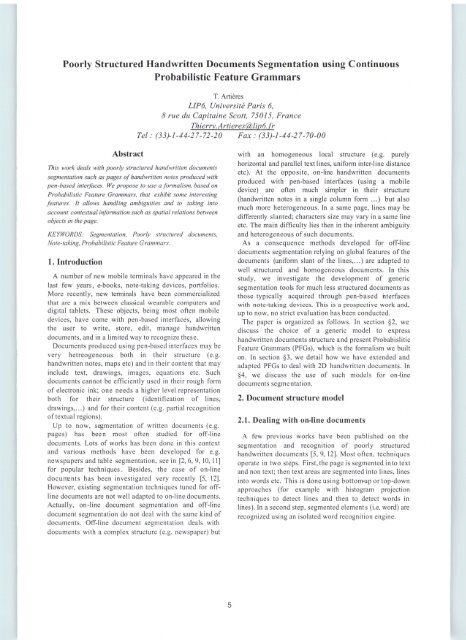RR_03_02
RR_03_02
RR_03_02
You also want an ePaper? Increase the reach of your titles
YUMPU automatically turns print PDFs into web optimized ePapers that Google loves.
Poorly Structured Handwritten Documents Segmentation using Continuous<br />
Probabilistic Feature Grammars<br />
Abstract<br />
This work deals with poorly structured handwritten documents<br />
segmentation such as pages of handwritten notes produced with<br />
pen-based interfaces. We propose to use a formalism, based on<br />
Probabilistic Feature Grammars. that exhibit some interesting<br />
features. It allows handling ambiguities and to taking into<br />
account contextual information such as spatial relations between<br />
objects in the page.<br />
KEYWORDS: Segmentation. Poorly structured documents.<br />
Note-taking, Probabilistic Feature Grammars.<br />
1. Introduction<br />
A number of new mobile terminals have appeared in the<br />
last few years, e-books, note-taking devices, portfolios.<br />
More recently, new terminals have been commercialized<br />
that are a mix between c lassical wearable computers and<br />
digital tablets. These objects, being most often mobile<br />
devices, have come with pen-based interfaces, allowing<br />
the user to write, store, edit, manage handwritten<br />
documents, and in a limited way to recognize these.<br />
Documents produced using pen-based interfaces may be<br />
very hetreogeneous both in thei r structure (e.g.<br />
handwritten notes, maps etc) and in their content that may<br />
include text, drawings, images, equations etc. Such<br />
documents cannot be efficiently used in their rough form<br />
of electronic ink; one needs a higher level representation<br />
both for their structure (identi fication of lines,<br />
drawings, ... ) and for their content (e.g. partial recognition<br />
of textual regions).<br />
Up to now, segmentation of written documents (e.g.<br />
pages) has bee n most often studied for off-line<br />
documents. Lots of works has been done in this context<br />
and various methods have been developed for e.g.<br />
newspapers and table segmentation, see in [2,6,9, 10, II]<br />
for popular techniques. Besides, the case of on-line<br />
docurrents has been investigated very recently [5, 12].<br />
However, existing segmentation techniques tuned for offline<br />
documents are not well adapted to on-line documents.<br />
Actually, on -line document segmentation and off-line<br />
document segmentation do not deal with the same kind of<br />
documents. Off-l ine document segmentation deals with<br />
documents with a complex structure (e.g. newspaper) but<br />
T. Artieres<br />
LlP6, Universite Paris 6,<br />
8 rue du Capitaine Scott, 75015, France<br />
Thierrv.Artieres@lip6.[r<br />
Tel: (33fl-44-27-72-20 Fax: (33)-1-44-27-70-00<br />
5<br />
with an homogeneous local structure (e.g. purely<br />
horizontal and parallel text lines, uniform inter-line distance<br />
etc). At the opposite, on-line handwritten documents<br />
produced with pen-based interfaces (using a mobile<br />
device) are often much simpler in their structure<br />
(handwritten notes in a single col umn form ... ) but also<br />
much more heterogeneous. In a same page, lines may be<br />
differently slanted; characters size may vary in a same line<br />
etc. The main difficulty lies then in the inherent ambiguity<br />
and heterogeneous of such documents.<br />
As a consequence methods developed for off-l ine<br />
documents segmentation relying on global features of the<br />
documents (uniform slant of the lines, ... ) are adapted to<br />
well structured and homogeneous documents. In this<br />
study, we investigate the development of generic<br />
segmentation tools for much less structured documents as<br />
those typically acquired through pen-based ilterfaces<br />
with note-taki ng devices. This is a prospecti ve work and,<br />
up to now, no strict evaluation has been conducted.<br />
The paper is organized as follows. In section §2, we<br />
discuss the choice of a generic model to express<br />
handwritten documents structure and present Probabislitic<br />
Feature Grammars (PFGs), which is the formalism we built<br />
on. In section §3, we detail how we have extended and<br />
adapted PFGs to deal with 2D handwritten documents. In<br />
§4, we discuss the use of such models for on-line<br />
documents segme ntation.<br />
2. Document structure model<br />
2.1. Dealing with on-line documents<br />
A few previous works have been published on the<br />
segmentation and recognition of poorly structured<br />
handwritten documents [5,9, 12]. Most often, techniques<br />
operate in two steps. First, the page is segmented into text<br />
and non text; then text areas are segmented into lines, lines<br />
into words etc. This is done using bottoITHlp or top-down<br />
approaches (for example with histogram projection<br />
techniques to detect lines and then to detect words in<br />
lines). [n a second step, segmented elements (i.e. word) are<br />
recognized using an isolated word recognition engine.


